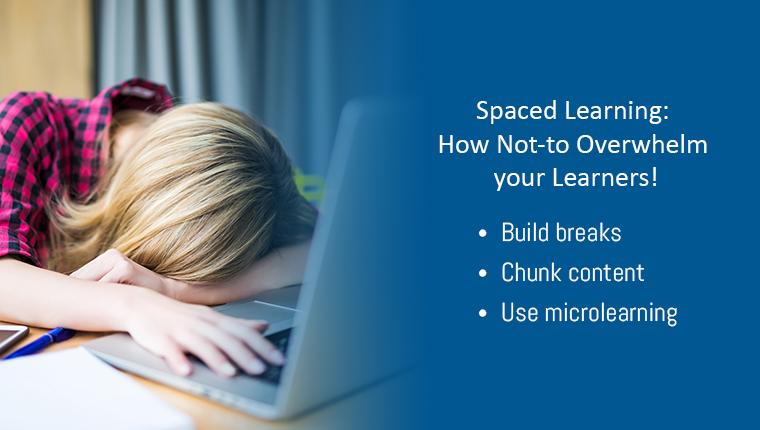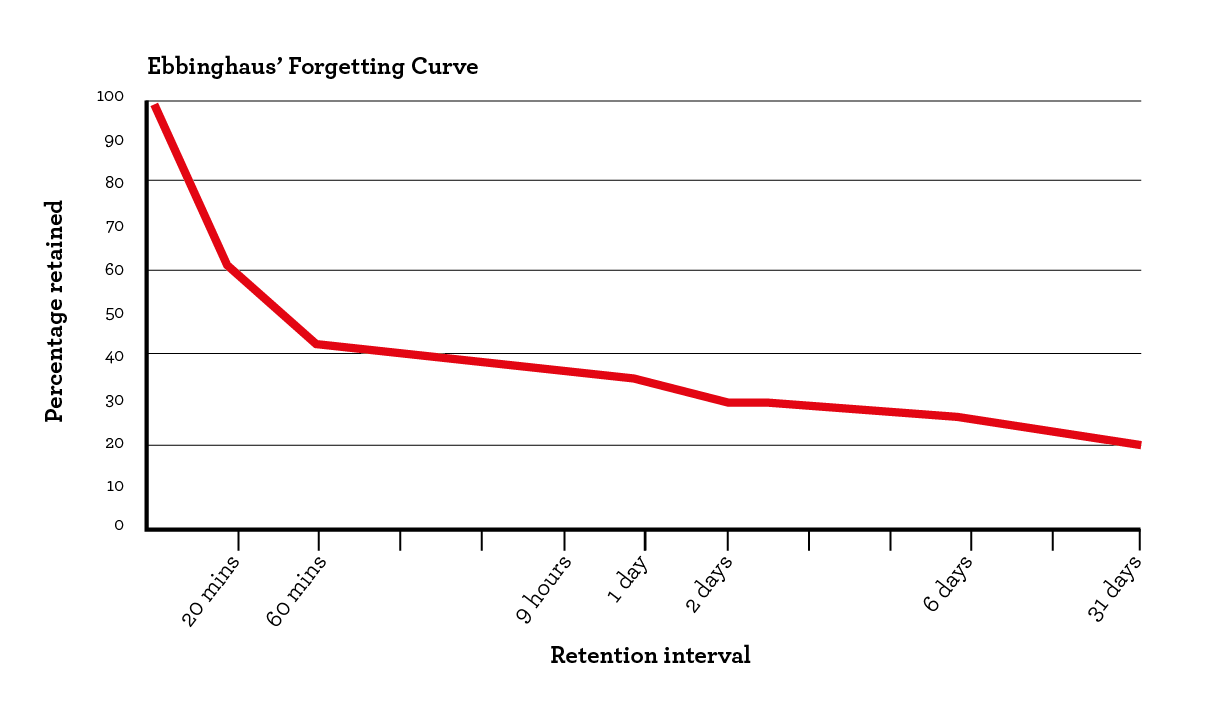Spaced Learning: The Ambrosia for Knowledge Retention

LL earning is not a one-time event, it’s a process. The concepts of cognition, learning, and memory and how they relate to our brain has fascinated neuroscientists, psychologists, and educational theorists since ages. German psychologist Hermann Ebbinghaus came up with two concepts – the learning curve and the forgetting curve. The Learning Curve refers to the time required to learn something new. The Forgetting Curve is the rate at which we forget newly acquired information. Drawing on these ideas, Dr Paul Kelley, a British neuroscientists and educator, built on the idea of Spaced Learning to enhance knowledge retention.

Source: https://fs.blog/
Kelley, in his paper, “Making long-term memories in minutes: a spaced learning pattern from memory research in education”, explains how learning should be spaced across a certain time interval and repeated, retrieved, and reinforced over and over again. Only then can learned knowledge be stored in the long-term memory.
Spaced Learning assumes that our brain works like a filing cabinet. All our thoughts and information are filed as temporary memories at first. Overtime, to make space for new information, older files are thrown down the shredder. To avoid losing these memories, we need to regularly re-visit them, understand their meaning and reinforce them.
Spaced Learning: The Mantra for Enhancing Knowledge Retention
Spaced Learning is a learning approach which proposes learning should be spaced across a certain interval of time.
Ways to implement spaced learning:
- Build breaks within a course
- Chunk content
- Offer repetition
- Have assessments
- Use active retrieval strategies
Why Should You Implement Spaced Learning in the Workplace?
You must probably be weighing the idea to space out your employee training programs. And your hesitance is understandable considering how fast the business world runs and the limited time allotted for training. However, the benefits of spaced learning far outweigh the damage perpetuated in its absence. Adopting spaced learning will:
- Prevent cognitive overload and won’t overwhelm learners with too much information in a single dose.
- Help in beating the forgetting curve and promoting effective knowledge retention.
- Connect knowledge with the performance expected at work because the learner is forced to actively recall information and apply it during the learning journey.
How Can You Implement Spaced Learning in the Workplace?
Traditionally, full-fledged instructor-led training made spaced learning difficult to implement in the workplace. ILT is time and cost consuming in itself, which made spacing unfeasible and impractical, for then employees would be stuck in the training cycle forever. But as organizations are transitioning from ILT to eLearning, there is an unavoidable need to implement spaced learning for a successful training experience. Here is how you should go about it.
Build Gaps: ‘Give them a Break!’
According to neuroscientific researches, our brain can focus on a single thing for only 20 minutes at a stretch. Beyond that, it will experience fatigue and get distracted. So making learners go through courses for hours and hours at end won’t serve any purpose because most knowledge will be lost before you can make any attempt to retain it.
However, if you build regular breaks both within the course and the training program, learners will have the much-needed break to relax, reflect, and generate insights on what they learned. You can ensure this by adding a quick summary or a feedback slide between two topics within a course to give learners tine to wrap their mind around the information and provide a seamless transition to the next topic. Include think breaks in the form of icebreakers or open-ended questions that’ll help them think of how the knowledge shared until then would help them at work. Within a training program, you can use microlearning modules instead of lengthy courses to provide short and easily digestible information.
The key to effective spacing is knowing when to give a break, and when to resume the training. You do not want to have too long a gap in which learners will forget what they learned. On the other hand, not enough time between learning will create cognitive overload.
Chunk Content: ‘Good Things Come in Small Packages’
When you’re trying to build breaks in the learning journey and spread out training across a time frame, it is very important to maintain a smooth flow of learning. Just because you’re giving breaks doesn’t mean you need to cram the learning module with every piece of information you can find. Spacing out essentially means chunking content into small packages and delivering them one after other, at regular intervals.
This is why microlearning has suddenly caught wind in the L&D market. It is a flexible learning approach where each learning module consists of concise and chunked content – fulfilling only one learning objective. Moreover, chunking makes the module ideal for use in different modalities, be it videos, infographics, quizzes, flashcards, or any eLearning format.
Offer Creative Repetition: ‘Several Roads Lead to the Same Castle’
Repeat, repeat, repeat. There is no better and effective road to proficiency than constant practice. However, the secret here is to repeat content without being repetitive. ELearning gives instructional designers many opportunities to frame the same content in different formats such as videos, scenarios, games, and simulations.
This engages learners with the same content while giving them different learning experiences which reinforces knowledge. Plus, learners also get the choice to pick from various modes of training. In case your organization has a blended learning approach in place, you can always make use of workshops, virtual classrooms, coaching and mentoring alongside eLearning strategies.
Include Assessments: ‘Regular Evaluation is the Road to Retention’
Asking questions is best to catch the attention of learners. It immediately puts learners on guard and activates their mental processes. Assessments in eLearning aren’t just ways to review and gauge learners’ qualification. It is an efficient way of repeating learned information, retrieving prior knowledge, and reinforcing it to build concepts. Assessments can be framed in the following ways:
Pre-Assessments: These assessments are built to enable the learner recall information prior to training. This allows them to connect the present course to previous their knowledge and make sense of what will follow.
Formative Assessments: These assessments are built at the end of each learning point within a course. They give a brief recap of what learners just learnt in the module and reinforces learning.
Summative Assessments: These assessments are designed at the end of a course to test learners. They are usually qualifying in nature but still serve to reinforce whatever knowledge was learned.
Review Assessments: These assessments can be designed to test employees’ retention after a long gap from training. This way, the next training can focus on repeating precisely the parts learners had difficulty retaining.
Use Active Retrieval Strategies: ‘Scenarios, Simulations and Gameplay, Keep Amnesia Away’
Instructional strategies such as branched scenarios, simulations, and game-based designs make learners willing and active participants in the learning experience. These learning formats gear mental processes into an overdrive and require learners to actively recall what they have learned and apply them effectively.
Branched Scenarios give learners a context to where and how they can use information. It allows learners to connect knowledge with real-life situations and forces them to make intelligent decisions. Using simulations is another way to build learners’ retention of skill-based tasks. Games tap into the competitive spirit of learners and motivate them to actively apply their knowledge to solve a problem or move a level ahead. It makes learning fun and induces the feeling of gratification through reward points, badges, and other scoring elements. These strategies can be incorporated in microlearning modules and “pushed” to learners at regular intervals to promote spaced learning.
Learning in the workplace is utilitarian. It is not driven by curiosity or pleasure. Organizations invest in employee training to hone their skills and train them to perform their best on job. Spaced Learning is an effective approach to increase knowledge retention and thereby, enhance employee productivity. Adapting spaced learning is even more easy and effective when methodologies such as microlearning are used. To know more about the topic, download our eBook, “Where Does Microlearning Fit in Your Learning Strategy?”




![5 Effective Ways to Incorporate Spaced Learning in E-Learning [Infographic]](https://blog.commlabindia.com/hubfs/Imported_Blog_Media/spaced-learning-knowledge-retention-main.jpg)
